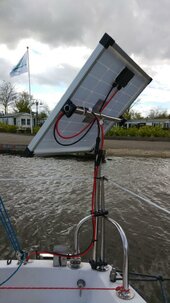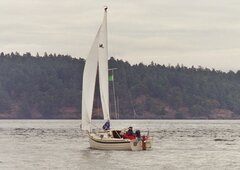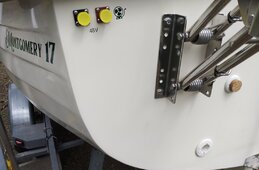I have the other thread about electric propulsion on our sailboat, which is wired and ready for the motor to arrive.
Some discussion about our initial decision to not install solar has me reconsidering it.
The boat is not large (17 foot sailboat) but will be likely towing a Portland Pudgy dinghy (unsinkable, sort of a rotomolded thingy)
I am now thinking that if we do add solar, it would be best to not have it fixed anywhere, but rather as portable and stowable as possible.
This has me looking at the BougeRV CIGS panels, perhaps the 200 watt version, which is about 83 inches by 27 inches. One option would be to sew two of these on to a piece of Sunbrella fabric with some ultra reinforced stainless steel grommets in the fabric, to create sort of a solar tarp that is 86" x 57" inches or thereabouts. We could then drape this over the dinghy with some lashing, or toss it on the foredeck when not actively sailing, or even put it on a boom tent for when moored somewhere during the day without access to shore power. The whole thing could roll up into a 30 inch tall, 16 inch diameter bundle which we could just lash to the transom or toss in the bilge. Perhaps we could even hank this thing on to the forestay and put a halyard on it, lift it up like a DIY solar sail of sorts for windless days where the sun is low. The flexibility and durability of the CIGS seem like they could handle this type of abuse.
The considerations:
1) How do we get the right voltages for our system. The open circuit voltage of the 200 watt panel is around 30V. Thus two in series is 60V and I am thinking this is not enough overhead for a 48V lithium bank, which needs 56 volts or so for charging. There are not very many boost charge controllers, none in blue that I know of. Should we consider THREE 200 watt panels? The fabric idea starts to get a bit large at 86" x 84" and might not fit on the foredeck or across the dinghy. Alternatively, the 100 watt panels are 83" x 14" and have a open circuit voltage of the same 30 volts, so three would be 90V which is plenty of overhead for a 48V bank. The downside here is 300 watts is not a lot. Might only expect an average of 210 watts for 6 hours, or 1230 watt-hr a day from 300 watts of panels, vs maybe 1680 watt-hr per day for the 400 watts of panels (just my guestimates here, although the CIGS is supposed to be really good for shading and such).
The other idea is use 6 of the 100 watt panels and make two of the fabrics, 86" x 50" and wire them series parallel, still giving you 90V. Now you have added quite a bit of extra connectors and wire vs using two or three of the 200 watt panels in one fabric.
Thoughts?
Some discussion about our initial decision to not install solar has me reconsidering it.
The boat is not large (17 foot sailboat) but will be likely towing a Portland Pudgy dinghy (unsinkable, sort of a rotomolded thingy)
I am now thinking that if we do add solar, it would be best to not have it fixed anywhere, but rather as portable and stowable as possible.
This has me looking at the BougeRV CIGS panels, perhaps the 200 watt version, which is about 83 inches by 27 inches. One option would be to sew two of these on to a piece of Sunbrella fabric with some ultra reinforced stainless steel grommets in the fabric, to create sort of a solar tarp that is 86" x 57" inches or thereabouts. We could then drape this over the dinghy with some lashing, or toss it on the foredeck when not actively sailing, or even put it on a boom tent for when moored somewhere during the day without access to shore power. The whole thing could roll up into a 30 inch tall, 16 inch diameter bundle which we could just lash to the transom or toss in the bilge. Perhaps we could even hank this thing on to the forestay and put a halyard on it, lift it up like a DIY solar sail of sorts for windless days where the sun is low. The flexibility and durability of the CIGS seem like they could handle this type of abuse.
The considerations:
1) How do we get the right voltages for our system. The open circuit voltage of the 200 watt panel is around 30V. Thus two in series is 60V and I am thinking this is not enough overhead for a 48V lithium bank, which needs 56 volts or so for charging. There are not very many boost charge controllers, none in blue that I know of. Should we consider THREE 200 watt panels? The fabric idea starts to get a bit large at 86" x 84" and might not fit on the foredeck or across the dinghy. Alternatively, the 100 watt panels are 83" x 14" and have a open circuit voltage of the same 30 volts, so three would be 90V which is plenty of overhead for a 48V bank. The downside here is 300 watts is not a lot. Might only expect an average of 210 watts for 6 hours, or 1230 watt-hr a day from 300 watts of panels, vs maybe 1680 watt-hr per day for the 400 watts of panels (just my guestimates here, although the CIGS is supposed to be really good for shading and such).
The other idea is use 6 of the 100 watt panels and make two of the fabrics, 86" x 50" and wire them series parallel, still giving you 90V. Now you have added quite a bit of extra connectors and wire vs using two or three of the 200 watt panels in one fabric.
Thoughts?








